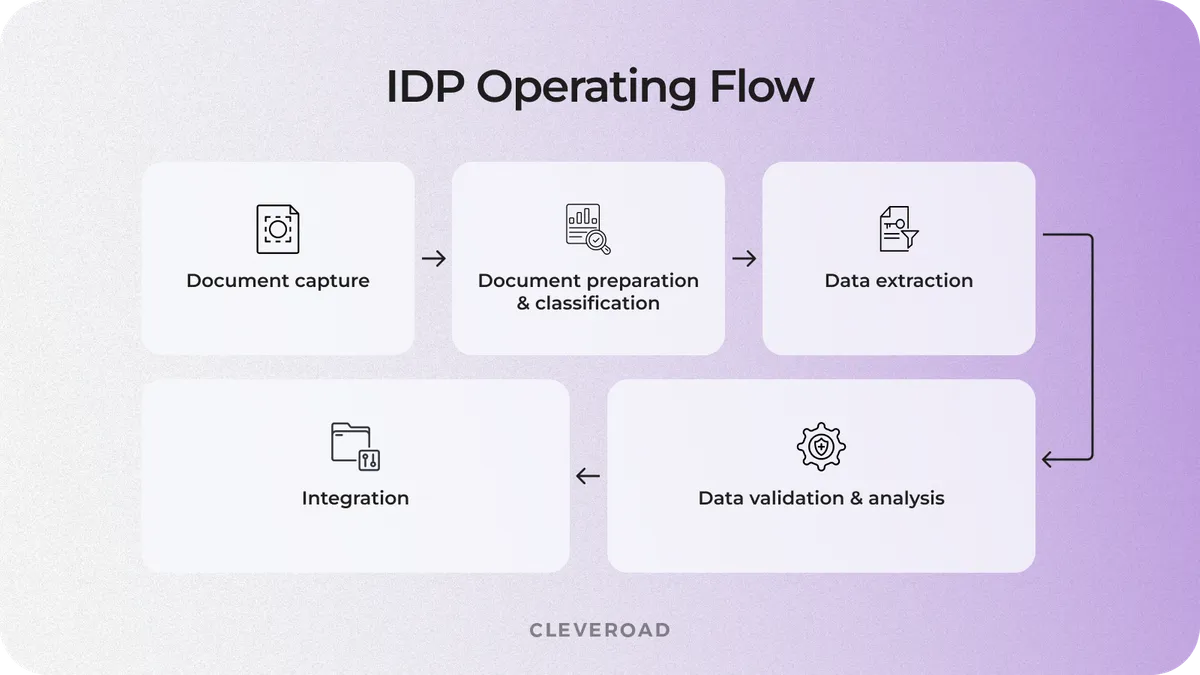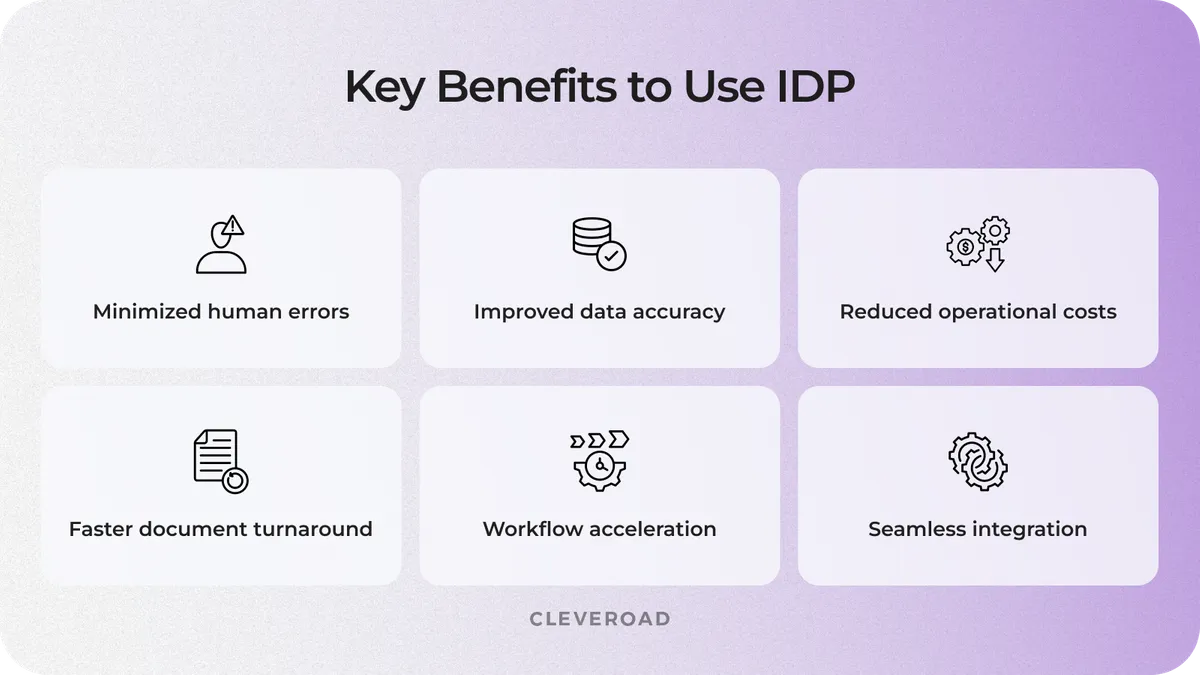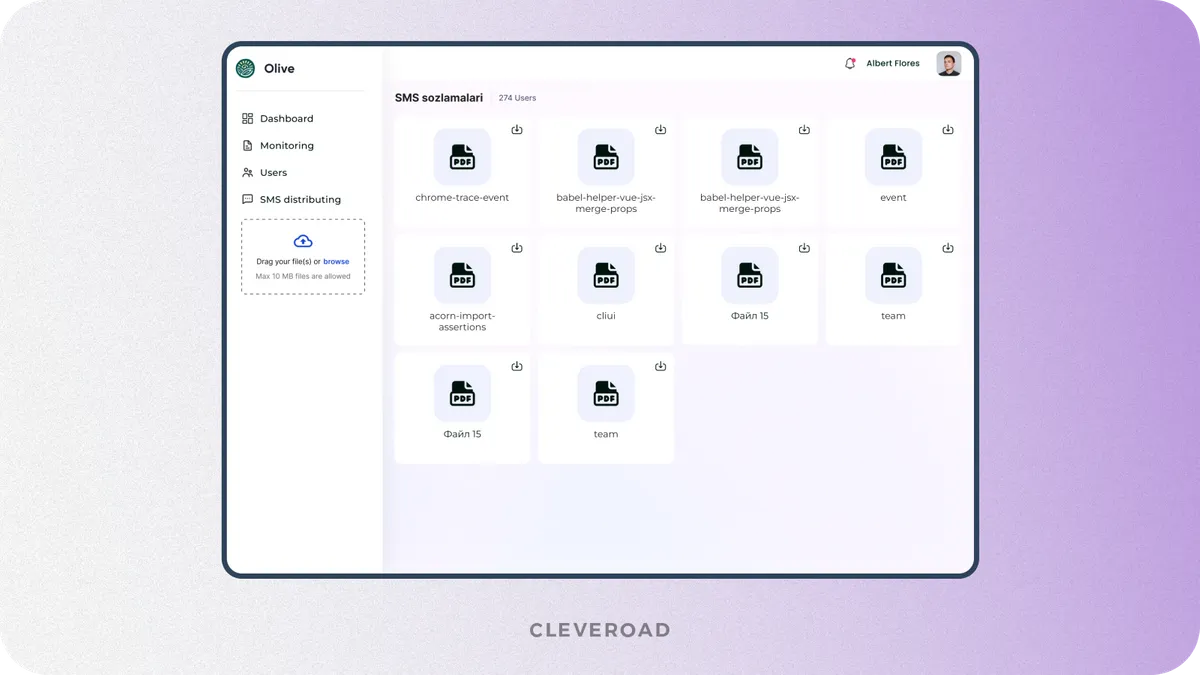Intelligent Document Processing: Use Cases, Benefits, Implementation Guide
15 Jul 2025
19 Min
125 Views
Intelligent document processing (IDP) transforms the way you handle unstructured data by applying AI to read, extract, and analyze documents at scale. From invoices and contracts to insurance claims and onboarding forms, IDP helps your company automate workflows, reduce human error, and boost productivity across industries.
At Cleveroad, we leverage IDP to automate document-centric workflows: from parsing NDAs and generating Statement of Work (SoW) templates to routing internal leave requests and invoice validation, integrated directly into our CRM and HR systems. We also delivered several IDP integration projects for our clients from Insurance and Healthcare domains, helping them streamline claims processing and reduce manual workload.
Based on our hands-on experience, we’ve compiled this detailed guide that walks you through 5 best IDP use cases for various industries, their strategic benefits, and a proven implementation process to get your business going with intelligent document processing for your company.
Key takeaways:
- IDP combines OCR, NLP, and machine learning to extract, classify, and validate data from unstructured documents with minimal human input.
- When integrated with RPA, IDP enhances workflow automation by eliminating repetitive tasks and enabling end-to-end document lifecycle management.
- IDP is widely used across industries, from invoice processing in finance and EHR data extraction in healthcare to customs forms classification in logistics and claims automation in insurance.
- A successful IDP implementation requires clear business goals, data source preparation, PoC validation, and phased deployment with human-in-the-loop mechanisms for handling exceptions.
What Is Intelligent Document Processing?
Intelligent Document Processing (IDP) is a computer-automated, AI-driven technology that automatically captures, classifies, extracts, and processes data contained in structured, semi-structured, and unstructured documents. While legacy tools (e.g., rule-based data extraction systems, or traditional OCR) are limited to "reading" static text, IDP learns context, data variation, and improves accuracy over time through the use of Optical Character Recognition (OCR), Natural Language Processing (NLP) technology, Machine Learning (ML) algorithms, and rule-based automation.
IDP systems work through documents that are pulled from a variety of sources: scanned documents, hand-written papers, PDFs, email, or web forms, and through a variety of automated procedures:

How IDP-equipped software works
Modern IDP solutions can learn from corrections and user feedback, which means they get smarter with each document processed. This makes them ideal for large-scale document-heavy operations across different industries.
If you want to get rid of manual data entry, human mistakes, and boost decision-making, intelligent document processing can help. IDP is a key part of full automation and is already used successfully in industries like finance, healthcare, logistics, insurance, and so on.
Why invest in IDP
Adopting intelligent document processing is a strategic move for businesses aiming to reduce costs, increase data accuracy, and improve process agility. Let’s look at what current research and market insights say on the perspectives of IDP usage:
- According to Diginomica, more than 80% of enterprise data is unstructured. IDP plays a critical role in extracting value from this data for automation and analytics.
- McKinsey research states that companies using IDP report a 30–50% reduction in manual processing time for document-heavy workflows.
- The global IDP market is projected to reach $6.8 billion by 2027, growing at a CAGR of 37.5%, considering MarketsandMarkets data.
- A Docsumo statistics aggregator found that implementing IDP in business workflows results in ROI growth of 30%-200% in the first year of automation.
These stats highlight one clear direction: IDP isn't a trend, but an efficiency driver. Whether for finance, healthcare, insurance, or logistics, companies investing in intelligent document automation gain measurable benefits in speed, accuracy, and compliance.
Leading experts emphasize that IDP delivers tangible results with minimal disruption to existing workflows, as noted by Amy Jones:
Amy Jones
U.S. Public Sector AI Lead, EY
IDP offers a low-effort, high-reward opportunity to enhance existing systems. By incorporating AI-driven IDP, agencies can eliminate these bottlenecks, streamline operations and ensure more accurate, real-time information throughout the process.
IDP and RPA: why they should cooperate
Pairing Intelligent Document Processing (IDP) use cases with Robotic Process Automation (RPA) creates a powerful synergy that drives end-to-end automation of complex workflows. While IDP focuses on extracting, classifying, and understanding unstructured content from various formats (such as PDFs, scans, or handwritten forms), RPA automates the rule-based business processes.
Together, they allow enterprises to process documents at scale and with precision. For instance, in claims processing, IDP can extract relevant data from forms or supporting evidence, while RPA bots input the operational data into back-office systems, trigger decisions, or generate responses with zero human intervention.
Combining Intelligent Document Processing (IDP) with Robotic Process Automation (RPA) delivers major benefits in document-heavy industries like finance, where speed, accuracy, and compliance matter. While RPA handles routine workflows, IDP adds flexibility by extracting and interpreting complex, variable data — even from semi-structured formats. Together, they create seamless, scalable, and auditable automation pipelines that reduce manual work, improve throughput, and lay the groundwork for broader digital transformation across sectors.
As companies advance toward intelligent automation, many turn to generative AI development services to complement IDP and RPA with contextual decision-making, enabling even greater autonomy in document-centric operations.
Discover more use cases of RPA in banking sector while reading our guide!
Major Benefits of Using Intelligent Document Processing For Your Business
Implementing IDP allows companies to move beyond manual document management and unlock strategic value across operations. Here are the key benefits that address both the goals and pain points of modern businesses regarding the IDP topic:
Minimized human errors and improved data accuracy
By using AI to extract relevant information from both structured and unstructured data, IDP reduces reliance on manual input. This leads to higher accuracy and reliability, critical for decision-making and reducing the risk of non-compliance.
IDP intelligently handles layout shifts and structure changes, streamlining data extraction from any document type. With built-in validation steps and confidence scoring, IDP solutions also flag uncertain fields for human review, helping teams focus only on edge cases while maintaining flow quality.
Reduced operational costs through automation
Intelligent document processing use cases can dramatically lower overhead by minimizing repetitive manual labor in activities like invoice management or HR onboarding. Organizations leverage IDP to optimize staff workload and boost operational efficiency across various departments.
Faster document turnaround and workflow acceleration
IDP streamlines the document process for the high-volume segment, reducing the amount of time spent pulling and routing information out of documents by a significant amount. For the banking, insurance, and logistics domains, all of which have the turnover directly impacting customer satisfaction as well as regulatory compliance, it certainly does make a significant difference.
Eliminating the bottlenecks, the Intelligent Document Processing reduces days-long waits to just a couple of minutes. Data-driven intelligent workflows powered by IDP work their way back and forth through systems and teams effectively, in loan approval, freight documentation and so on.
Seamless integration with existing systems
Modern IDP tools connect easily with systems like ERP, CRM, and document storage platforms, so you don’t have to change how your team works. You can add AI to your existing software without replacing it, so you’ll see results faster and avoid a messy transition.

Benefits of IDP integration for businesses
Key Intelligent Document Processing Use Cases Across Industries
Intelligent Document Processing (IDP) is gaining acceptance across industries where document-intensive workflows are a bottleneck. As a way to process several document types, IDP helps streamline operations, enhances accuracy, and cuts down manual effort. Below are the most relevant use cases of intelligent document processing per industry.
Healthcare
Healthcare IDP addresses both operational and compliance needs by processing different document types securely and accurately, from intake forms to insurance claims and beyond.
Here are core business cases of IDP use for Healthcare:
Patient onboarding
Manual registration often involves collecting insurance cards, personal IDs, consent forms, and medical histories that are usually scanned or filled out on paper. Staff must manually verify and enter this data into EHR systems, which slows down check-ins and increases the chance of errors.
IDP solution: Intelligent document processing automates intake by extracting data from ID scans, insurance forms, and consent documents in real time. The system classifies each file, pulls key fields (e.g., policy number, patient ID), and prepares structured data for secure transfer to the EHR system, accelerating routine tasks and minimizing human error. This reduces clerical workload and shortens onboarding time, enabling faster access to care.
Clinical documentation
Pharma and research teams work with lab results, trial summaries, and handwritten physician notes. Manually converting these into structured data for compliance or study reporting is time-consuming and error-prone.
IDP solution: Modern IDP solution extracts structured values from lab reports, and recognizes handwritten text with high accuracy. This ensures documentation is audit-ready and accelerates regulatory submission workflows.
Regulatory compliance
HIPAA and similar laws require strict control over how patient data is stored, accessed, and shared. Manual processing makes it difficult to ensure full traceability and control, especially across teams or medical facilities.
IDP solution: IDP applies access rules and document tagging automatically. It logs document handling activity, ensures only authorized access, and flags missing fields — helping healthcare providers stay compliant without adding administrative burden.
Post-care engagement
After discharge, patients often submit feedback forms, receive follow-up plans, or return physical documents. Without structured processing, this information is hard to track and use for healthcare service improvements.
IDP solution: IDP captures feedback and discharge forms, turning unstructured responses into analyzable data. Hospitals and clinics use this data to personalize follow-ups, improve treatment protocols, and optimize patient satisfaction programs.
By using these IDP solutions, healthcare providers can streamline medical billing, reduce invoice errors, and accelerate payment processing, improving overall revenue cycle efficiency. And with IDP's adaptability to various document types, it scales effortlessly from individual clinics to large hospital or clinics networks.
Explore our guide on EHR software development to find out how to create an ultimate system where IDP for healthcare benefits you the most
Financial services and banking
Document processing is central to operations of financial institutions, from onboarding and compliance to lending and audits. Manual handling of statements, loan forms, invoices, and identity documents slows down workflows, increases error rates, and raises compliance risks.
Let’s revise the key examples of using IDP in financial services and banking:
Client onboarding
Banks must verify identity documents, proof of address, and financial disclosures to onboard customers. Manual review creates bottlenecks and makes it difficult to meet onboarding timeframes.
IDP solution: IDP extracts data from passports, driver’s licenses, and utility bills, validates fields against internal databases, and flags inconsistencies for review. This reduces onboarding time while supporting KYC/AML compliance.
Loan processing
Loan origination requires parsing income statements, tax forms, and credit reports, often in inconsistent formats. Delays in document handling slow down approvals and frustrate applicants.
IDP solution: IDP reads structured and unstructured documents, pulls required fields (e.g., income, debt ratio), and normalizes the data for scoring models. This reduces processing time and helps underwriters make faster, data-driven decisions.
Invoice and payment processing
Accounts payable teams often process thousands of invoices from vendors, each with different layouts and payment terms. Manual entry slows down payments and causes mismatches.
IDP solution: Intelligent document processing extracts invoice numbers, amounts, vendor data, and due dates, integrating this data into ERP systems. This reduces payment delays, and improves vendor relationships.
By adopting IDP, financial institutions reduce manual workload, increase transaction accuracy, and stay agile in regulated environments. The technology supports faster service delivery without compromising on data integrity or compliance standards.
Insurance
In the insurance industry, document handling is a core operational function: from processing new applications to managing claims and renewals. Now, we’ll find out how IDP helps to boost the workflows in the domain.
Policy application review
New policy applications often arrive as PDFs, scanned forms, or digital attachments containing personal information, coverage selections, and health declarations. Manual validation of this data against internal systems is time-consuming and inconsistent.
IDP solution: Intelligent document processing captures applicant data (e.g., names, addresses, coverage details) from unstructured sources and verifies it against policy management systems. It flags anomalies, incomplete fields, and formatting issues, accelerating onboarding while ensuring data quality and so on.
Claims assessment
Insurance claims may include handwritten notes, scanned doctor reports, receipts, or accident photos. Manual entry of these documents slows down approvals and creates compliance risks.
IDP solution: IDP systems extract relevant fields from each claim (e.g., claim number, treatment cost, incident date), classify document types, and route them to the right reviewers. Low-confidence entries are flagged for human validation, enabling faster and more accurate claims processing.
Fraud and risk analysis
Analyzing historical claim trends and cross-referencing documents for fraud detection typically involves reviewing unstructured records across multiple channels.
IDP solution: IDP enables automated extraction of metadata from prior claims, loss histories, and behavioral patterns. Combined with analytics tools, this supports fraud detection and smarter underwriting decisions.
Customer inquiries
Emails, feedback forms, and claim follow-ups often arrive as free-text data, which is difficult to track and respond to quickly without structured intake.
IDP solution: IDP classifies incoming documents by intent and policy type, extracting sender details and key phrases. This supports intelligent routing, faster resolution, which is essential for a more responsive customer experience.
Using intelligent document processing, insurers reduce processing time and improve policyholder satisfaction. As operations scale, IDP adapts to evolving documentation formats, languages, and fraud-detection workflows, helping insurers maintain both agility and compliance.
Explore how to benefit from IDP in insurance: read our recent guide and learn more!
Logistics and supply chain
Logistics documentation is essential, driving processes from customs clearance and freight booking to vendor payments. Many of these workflows rely on physical or semi-structured formats like scanned bills of lading, invoices, delivery receipts, or packing lists.
Let’s look through the main examples of utilizing IDP in logistics.
Freight and customs documentation
Shipping carriers and freight forwarders handle large volumes of customs declarations, commercial invoices, and certificates of origin. These documents often vary by country and are submitted in scanned or PDF form.
IDP solution: Intelligent document processing extracts shipment details (e.g., cargo descriptions, weight, and origin/destination) and cross-validates entries for customs rules. This minimizes clearance delays, prevents rejections, and enables faster throughput across borders.
Proof of delivery and dispatch notes
After each shipment, drivers or dispatchers submit signed delivery notes or PODs. Manually logging them for every shipment takes time and slows billing.
IDP solution: IDP captures POD documents in bulk, pulls dates, locations, and receiver signatures, and routes them into ERP or transport management systems. This ensures real-time delivery confirmation and accelerates invoice generation.
Warehouse intake and packing documents
In distribution centers, workers receive shipments along with packing lists, pallet manifests, and intake reports, often printed or hand-filled. Manual entry into WMS slows throughput and creates mismatches in inventory records.
IDP solution: Intelligent document processing captures product quantities, and lot numbers from packing documents and automatically updates warehouse or ERP systems. This speeds up inbound processing, improves stock accuracy, and reduces labor at intake points.
Vendor invoice processing
Logistics providers must reconcile incoming invoices with delivery logs, POs, and goods receipts, often across multiple systems and formats.
IDP solution: Modern IDP tools automatically match invoice line items with delivery data, flag discrepancies, and trigger approvals. This reduces errors in payable cycles and boosts financial transparency across the supply chain.
By adopting IDP solutions, logistics companies reduce paperwork bottlenecks, shorten payment cycles, and improve SLA adherence: all while maintaining audit-ready records and better operational control.
Whether managing 3PL coordination or international freight, IDP adds structure to the most document-heavy processes in supply chain operations. This is crucial for modern, data-driven supply chain management.
Legal and professional services
Legal firms and business service providers deal with high document volumes: contracts, case files, NDAs, and client records, requiring strict accuracy and traceability. Manual review and data entry in legal workflows not only slow down delivery but also increase compliance risks.
Contract review
Law firms process hundreds of contracts, service agreements, and procurement forms, often under strict deadlines. Manually extracting clauses, terms, and renewal dates consumes attorney time.
IDP solution: IDP automatically extracts key contract metadata (such as parties, dates, obligations, and termination clauses) and formats them into searchable, structured fields. This accelerates legal review, reduces risk of oversight, and simplifies contract lifecycle management.
Case file digitization
Many legal practices still rely on scanned court filings, handwritten notes, and faxed case updates. Converting these into digital records is tedious and error-prone.
IDP solution: IDP recognizes printed and handwritten content in scanned case files, classifies documents by type, and organizes them by matter. This speeds up file preparation and ensures relevant information is accessible across the legal team.
Client onboarding and KYC
Legal service providers must verify client identity and perform compliance checks before engaging. Processing IDs, utility bills, and declarations manually leads to long onboarding times.
IDP solution: IDP extracts identity data from client-provided documents, validates information against compliance rules, and organizes records for audit readiness. It cuts onboarding time and improves accuracy in due diligence workflows.
Let's sum up the IDP business cases with the help of the table below:
| Industry | What documents are processed | Where IDP helps | What you gain |
Healthcare | Intake forms, consent docs, lab results, claims | Onboarding, documentation, compliance, post-care | Faster intake, HIPAA alignment, lower error rates |
Banking & finance | IDs, tax forms, credit reports, invoices | KYC onboarding, loan processing, AP automation | Shorter cycles, audit readiness, reduced risk |
Insurance | Applications, scanned claims, doctor notes, feedback | Claims, underwriting, fraud analysis, client queries | Faster claims, smarter risk profiling, better CX |
Logistics | Bills of lading, PODs, packing lists, customs forms | Shipment verification, warehouse intake, invoicing | Real-time confirmation, inventory accuracy, SLA boost |
Legal services | Contracts, scanned filings, case notes, NDAs | Contract review, file digitization, onboarding/KYC | Higher speed, searchable data, fewer compliance gaps |
Analyzing all these examples across different industries, you can see that deploying IDP software enhances productivity, accuracy, and document governance. Across all the domains given above, intelligent document processing use cases empower teams to scale operations, handle compliance, and deliver services faster. Whether you're processing claims, invoices, or contracts, the right IDP solution transforms how fast your company engages with documents and delivers real ROI.
Intelligent Document Processing Success Stories in Global Companies
Leading enterprises use IDP to simplify complex document workflows and achieve higher speed and better accuracy. Below are real-world examples of how enterprises across industries apply IDP to drive measurable results in activities like speeding up claims handling in insurance or simplifying contract management in legal departments.
Dexcom
Dexcom is a global leader in glucose monitoring technology. They used an IDP platform from UiPath to automate the intake of handwritten prescriptions received via fax and dot-matrix printouts. The company’s German branch faced a growing influx of prescription forms, rising from 300 to over 600 per week due to 50% annual order growth.
By digitizing these documents with OCR and routing low-confidence cases through human validation, Dexcom eliminated manual data entry bottlenecks. The IDP deployment helped reduce prescription processing cycle time by 80% and enabled Dexcom to scale operations without adding staff. As a result, the company is projected to save 200,000 employee hours annually while maintaining high data accuracy and supporting rapid business growth.
Pfizer
Pfizer completely transformed their R&D documentation processes when they adopted electronic intelligent document solutions (MSB Docs) for lab notebooks and regulated documentation. The new e-signing and electronic document process did away with paper-based approvals: previously involving manual shipment for signatures. The end-result was 85% cost reduction, about 90% faster document processing, drug development pipelines acceleration, and a total documentation efficiency improvement of 95%.
HBSC
Global banking giant HSBC implemented a customized IDP solution built on IBM technologies to automate the validation of trade finance documents, like invoices and insurance certificates, in Global Trade and Receivables Finance. The system extracts 65+ data points from each set of trade transaction packs, speeding up processing of nearly 100 million document pages every year. As indicated by ComputerWeekly, automation quickened transaction speeds, making them safer for customers, and reduced errors while enabling staff to spend more hours on value-add work. Compliance risk was also reduced through higher consistency in checks for AML/KYC on trade documentation.
These high-profile intelligent document processing use cases all show how IDP can drive cost reduction, increased accuracy/compliance, and higher productivity, in establishing smart automation of documents. At Cleveroad, we apply similar principles in designing IDP solutions for clients, starting from business-specific PoC implementations and guiding our clients to large-scale integration with custom workflow, third-party solutions, as well as regulation needs. Our experts make sure AI models work accurately and deliver real, measurable value for every industry.
How to Adopt and Integrate IDP in Real Business Operations
Whether you're working with tax forms, invoices, contracts, or medical records, IDP provides a scalable way to increase throughput while reducing manual overhead. Here is how intelligent document processing achieves the bottom-line benefits when you have a reliable tech partner to implement.
IDP use case definition
Start IDP implementation by outlining your business case, document flows, and desired outcomes. In this stage, your tech partner’s solution architects and domain experts work closely with your internal team to map current challenges and define success metrics. The step includes:
- Analyzing your aims, needs and current problems you want to solve
- Selecting relevant IDP use cases (e.g., invoice triage, contract validation) that’ll help you receive the real value in your business context
- Pinpointing specific needs (e.g., compliance needs, personal data protection, etc.)
Data analysis and preparation
At this stage, we analyze the document samples your system will process: their structure, formats, frequency, and noise level. We clean redundant data, normalize document layouts, and convert formats to ensure they’re compatible with the selected IDP system. This step helps increase model accuracy and prevents downstream errors during automation.
PoC IDP solution stage
To check whether IDP is a good fit for your business, we build a focused Proof of Concept (PoC): a small-scale version of an AI-based document processing system that covers one or two core document types and tests key functions like data extraction and classification. This PoC validates whether the IDP model can perform data extraction (e.g., vendor names, payment amounts, or account numbers) from real-world document sets.
We typically use pre-trained AI and machine learning models (e.g., Amazon Titan, Claude via Amazon Bedrock, or Google Vertex AI PaLM), customize them for your domain, and evaluate their performance on live datasets. We use pre-built AI models like Amazon Titan, Claude (via Bedrock), or Google Vertex AI, then adapt them to your business needs. After that, we test them on real documents to check how accurately they extract important fields. This helps prove they can speed up processing and cut down on errors.
Validate your IDP solution with our business-driven AI PoC development services
IDP solution development and integration
This is the stage where actual integration begins. We connect the IDP components with your core systems (like ERP, CRM, or QMS) through APIs or custom middleware, ensuring smooth document flow, real-time updates, and traceable outputs across platforms.
Once the PoC succeeds, we move into building a production-ready solution. Our team applies AWS-powered IDP components to enable document parsing, entity recognition, intelligent routing, and other automation capabilities.
Our AWS Select Tier Partner status confirms our cloud development expertise and helps us deliver reliable IDP solutions using the latest AWS technologies.
For example, we’ve successfully applied intelligent document processing into our recent project. One of our clients, Prime Path Medtech, a US medical device maker, needed a fully automated Quality Management System (QMS) to validate and track complex document workflows across departments. Our experts designed a module-oriented QMS that automates document flow, ensures traceability, and assists with FDA and ISO compliance. We used IDP to digitize and extract data from QMS documents, cutting manual review time and accelerating quality control at Prime Path Medtech.
Discover Breanne Butler’s successful partnership with Cleveroad:
Breanne Butler, Client Liaison Officer at Prime Path Medtech™
Maintenance and enhancements of IDP solution
Once deployed, your IDP solution will continue to evolve. Maintenance covers model re-training, performance monitoring, and adapting to new types of data and document formats. As your business grows, so will your IDP ecosystem, while potentially expanding into new intelligent document processing examples like legal disclosures, insurance claims, or supply chain documents.
By choosing Cleveroad for IDP implementation, you get long-term support with model performance reviews, security patching, and the ability to scale the solution across departments or regions. Contact us to turn manual paperwork into structured insights that drive speed and efficiency.
Why Hire Cleveroad for IDP Implementation
Cleveroad is a skilled software development company headquartered in Estonia, Northern Europe. We’ve been providing smart, business-driven software solutions for different industries (including Fintech, Healthcare, Logistics, Retail, eCommerce, and others) for over 13 years.
We help our clients automate document-based workflows by applying Intelligent Document Processing (IDP) technologies to enhance business efficiency, data precision, and customer satisfaction. If your business involves handling vast amounts of documents, we’ll help you identify and implement the most profitable IDP use case into your corporate ecosystem to streamline your business workflows and integrate.
By partnering with Cleveroad, you gain access to:
- Experts with an in-depth understanding of best document automation practices for B2B, B2C, and D2C business models, and tech capabilities to implement them using IDP
- Collaboration with an acknowledged IDP solution development vendor holding ISO/IEC 27001:2013 and ISO 9001:2015 certifications which ensures our adherence to world standards in data security management and quality assurance
- IDP connecting with your existing tools, from ERP to payment systems, to unify document processing across the entire workflow
- Deep knowledge of advanced technologies like AI, NLP, OCR, and machine learning to automate the classification, data extraction, and routing of unstructured documents
We'd like to present another of our accomplished IDP implementation cases: a Claims Management system. Our client, who is a major Norway-based insurance company, approached us to improve efficiency in claims processing, which still involved manual handling of policy and claim documents. Our team integrated IDP capabilities into their current system, enabling automatic classification of incoming documents and accurate data extraction to support regulatory compliance.
By deploying AI-driven document intelligence, our client reduced manual processing time by up to 75%, significantly increasing work efficiency and decreasing the likelihood of human errors.

AI-driven document intelligence system designed by Cleveroad
Integrate a resilient IDP solution into your business workflows
Cleveroad AI experts will help you build a robust IDP system to automate data extraction, integrate with internal workflows, and meet industry regulations
Intelligent Document Processing (IDP) is a data optimization technology that automates information extraction, categorization, and verification from unstructured documents using AI, NLP, and OCR. Organizations can automatically process document-based workloads, reducing manual work and minimizing the number of errors.
Intelligent document processing use cases include document classification, form extraction, insurance claims, bill payment, and onboarding workflows. It streamlines repetitive work such as routing, data entry, and validation in document-intensive processes.
Industries that can best benefit on Intelligent Document Processing (IDP) are:
- Financial services: Automate loan application, KYC, and compliance reporting processes in order to decrease turnaround time as well as human errors.
- Healthcare: Extract and aggregate data from patient charts, lab, and billing, streamlining clinical processes and administrative throughput.
- Insurance: Streamline claims processing, policy administration, and underwriting through the extraction of structured data from forms and reports.
- Logistics & supply chain: Digitalize and verify shipping papers, invoices, and customs forms for faster, smoother operations.
- Legal services: Classification and extraction of information from contracts, case files, and legal letters to speed up review procedures and reduce manual work.
Not necessarily: with cloud-based offerings and AI Proof of Concept services, companies can justify their IDP benefit at zero upfront cost. An incremental approach serves similarly to keep risks contained and scale investment proportional to real business value.

Evgeniy Altynpara is a CTO and member of the Forbes Councils’ community of tech professionals. He is an expert in software development and technological entrepreneurship and has 10+years of experience in digital transformation consulting in Healthcare, FinTech, Supply Chain and Logistics
Give us your impressions about this article
Give us your impressions about this article
